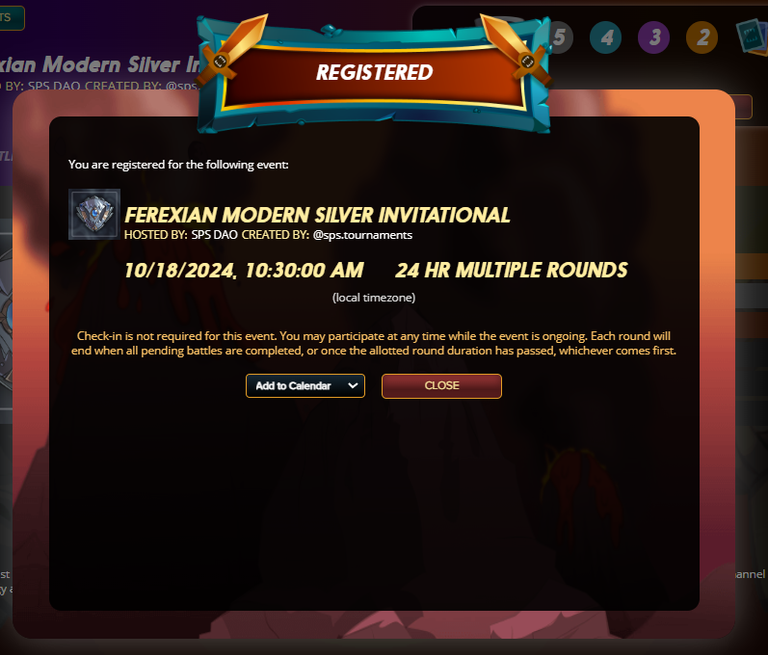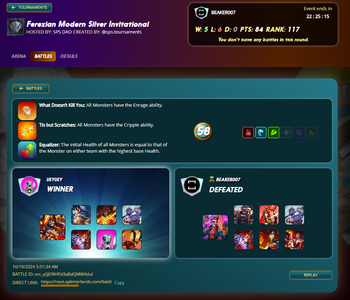A Newbie’s Guide to Tournaments in Splinterlands

Introduction
Tournaments are one of the exciting and competitive aspects of Splinterlands, offering players the chance to showcase their skills and win valuable rewards. However, as a new player, the idea of jumping into a tournament can feel overwhelming. Facing off against more experienced players might seem daunting at first, but don’t worry—there’s a way to ease into it. By starting slow in the lower leagues and giving yourself time to learn and adapt, you’ll find your confidence growing with each match.
Personally, I’m not the most competitive player, but I still enjoy diving into tournaments from time to time. It’s a great way to test my skills and see how far I’ve come. I often aim for tournaments where I feel I have a fair chance of at least earning back my entry fee. And while I don’t always win, I’ve noticed that the more I play, the more I enjoy the experience—win or lose.
This guide is here to help you get started, so you can confidently enter tournaments, grow your strategy, and hopefully walk away with some rewards!

How to Choose the Right Tournament
The first step to joining a tournament is navigating to the Tournaments tab in Splinterlands. You can either search for a specific tournament or browse through the available options.

Tournament Types

It’s essential to know the different types of tournaments, as they each have unique formats:
Single Elimination: Players are eliminated after each loss. The tournament starts when a minimum number of players has checked in. You must submit your teams for each round within a set time.
Anytime: You don’t need to check in. The tournament proceeds over multiple rounds, typically 24 hours per round, and your performance is based on wins, draws, and losses.
Sit N Go: This format can be either Single Elimination or Anytime. It starts automatically once the minimum or maximum number of players is reached, with no check-in required.
You can find a full breakdown of these formats in the official Splinterlands Tournament Guide.
Choosing the Right Tournament for You

- Check the Requirements(Qualified): Make sure you meet the entry conditions, which can include card power or staked SPS.
- Special Rules: Look for specific tournament rules that match your deck strength, such as "No Legendary Cards" or "Gold Cards Only."
- League Restrictions: Choose tournaments that fit your current league—Novice, Bronze, Silver, Gold, Diamond, or Champion—so you’re not outmatched.
- Format Wild / Modern: Filter modern (latest to sets) or wild (all sets) tournaments

- Specific Set: Filter Specific card set form left to right Alpha/Beta/Untamed/Dice/Chaos/Rebellion/Gladius

Selecting a tournament that fits your current experience level and card collection will give you the best chance to perform well and enjoy the experience.
Enter the tournament
Once you have found your tournament simple enter, pay the entry fee if there is one. Optionally you can create a agenda item in for example google/apple calendar



Preparing for Tournaments
Now that you've selected the right tournament, it’s not time to just sit back and wait for it to start—you need to prepare! Here are a few key ways to get ready:
1 - Practice Makes Perfect:
- Ranked Battles: Playing in ranked mode is another great way to prepare since you’ll be facing opponents similar to those in the tournament. In Modern format, you’ll always face real players, while in Wild format, you might encounter both real players and bots playing for them.
- Challenges: Another way to practice is by challenging friends. This helps you experiment with different strategies in a low-pressure environment.
- Spar with Splinterlands Bot (Practice mode): If you’re looking for even more practice, bots can be a useful way to refine your strategies without waiting for ranked matches.
2 - Study Opponents and Meta:
- Analyze Popular Lineups: Take the time to study the cards and lineups frequently used in your tournament’s league and ruleset. Knowing which summoners, monsters, and strategies are popular can give you an edge.
- Buy or Rent Key Cards: If you notice certain cards being used often, consider either buying or renting them. - Renting can be a cost-effective way to fill gaps in your collection without spending too much DEC.
3 - Review and Learn from Past Battles:
- Watch Replays: Use battle replays to analyze your own past matches as well as those of other players. See what worked and what didn’t.
- Battle Vision Tool (XBot): For a more in-depth analysis, use tools like the XBot Battle Vision to understand how specific changes in lineups or card combinations might have affected the outcome. This tool provides insights into matchups, win rates, and strategies that can help you improve your decision-making.
Here an example where i only had 30% change to win:

By practicing, studying your competition, and making sure you have the right cards on hand, you’ll be better prepared to face whatever comes your way in the tournament.

Tips for beginners
When you start fighting your battles, remember not to stress too much if you’re not winning right away. It takes time and practice to compete against some of the top players, and losing is part of the learning process.
In my last tournament, I faced the same opponent, UEYUEY, twice. Every time I see this name, I know it’s going to be a tough battle! But instead of getting discouraged, I use it as a learning opportunity. I watch their matches, study what they played, and ask myself, “Did they just have better cards, or could I have chosen a different strategy?” It’s all about adapting and improving. One day, I know I’ll beat them—whether by luck or a smarter strategy!


In that same tournament, I placed 117th out of 179 players. Sure, I’ve done better before, but I still managed to make back my entry fee, and most importantly, I had fun. For me, that’s a win-win.
Remember, as we discussed in the previous chapter, study your matches—especially the ones you lose. Watch replays, figure out where you could improve, and identify any key cards you might need for the next tournament. Each loss brings you closer to becoming a better player.

Closing notes
For me, one of the best aspects of Splinterlands is its variety of game modes—whether it's ranked battles, guild brawls, or tournaments. The last two, especially, offer a great way to engage with the community and sharpen your skills. After 2.5 years of playing Splinterlands daily, it’s still my number one game, and tournaments continue to be a key part of that experience.
In many ways, tournaments reflect what Splinterlands is all about: easy to play but challenging to master. You don’t have to rush—enjoy the journey at your own pace. Every match, win or lose, brings you one step closer to mastering your strategy.
If you have any questions about tournaments or if there’s something important I might have missed, feel free to drop a comment. I’d love to hear from you and help out however I can.
That's all for this week hope you enjoyed reading this post. See you all on the battlefield

Do you also want to be part of this amazing play to earn game consider using my refferal link.
Thanks for sharing! - @alokkumar121

very well explained about the tournament. good work